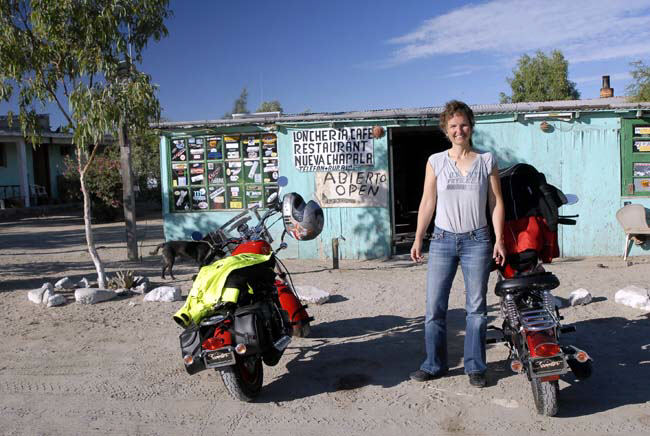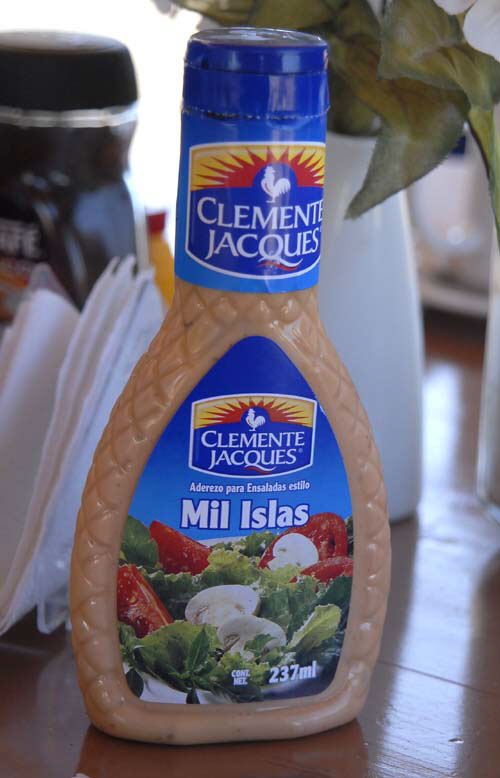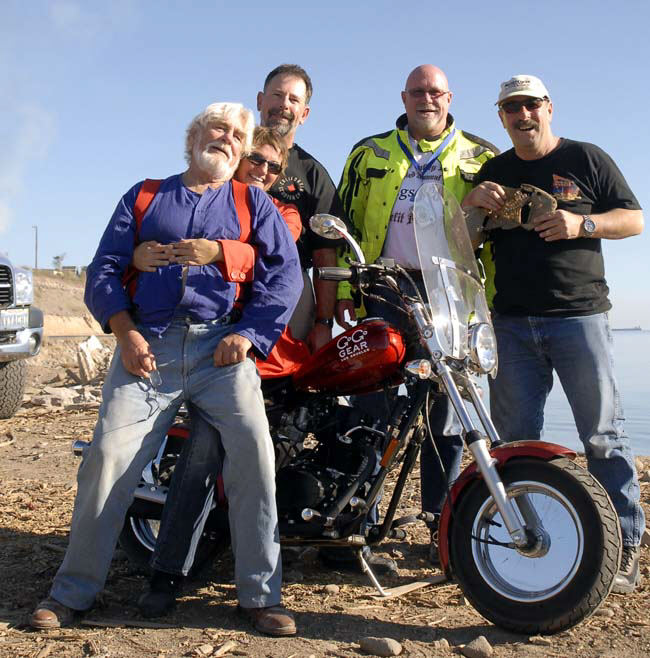The trek south on our 150cc California Scooter Mustang replicas continues…
If you are coming into this adventure in the middle of the movie, you might want to take a minute or two and get caught up with our first three installments…
Part I: Baja, 150cc at a time…
Part II: Baja, 150cc at a time…
Part III: Baja, 150cc at a time…
Back to the main attraction…
After the spending the night at the Desert Inn in Catavina, fueling the bikes and checking that everything was tight the next morning, we were ready to continue south. We had agreed that if the group separated (which happens on these trips), our next rally point would be Chapala. Sure enough, that’s what happened, and Arlene and I waited for John and Simon to catch up to us near Chapala. We had a soft drink and after waiting a bit, we pushed on. We’d catch John and Simon later.

We had left early that morning and the weather was tolerable, but it soon became a brutally hot. September is the hottest month of the year in Baja, and we were feeling it.

When we hooked up with Simon and John, they were eating a morning snack…a salad with 1000 Island dressing. We continued down Mexico’s Transpeninsular Highway, and I grabbed this shot of Simon and Arlene headed toward Guerrero Negro…

Guerrero Negro means “Black Warrior” in Spanish. It is the name of a ship that sank near there in the 1800s. Guerrero Negro is right on Parallelo 28 (the 28th Parallel), which separates the states of Baja California and Baja California Sur. The town is also a good spot in the winter months for whale-watching tours. There’s a Mexican Army compound on the highway, and they have this cool whale skeleton right next to the highway.

From Guerrero Negro, the highway cuts southeasterly across the Baja peninsula, and we moved from the Pacific side to the Sea of Cortez side of Baja.
Going across the Baja peninsula was a fun ride, especially the last few miles into Santa Rosalia. It’s a 2,000-foot descent in just a few miles, and it’s wild. The name of this stretch is La Cuesta del Infierno. There are no guard rails and nightmarish drops if you let things get away from you. I didn’t grab any photos on the way down. When we arrived on eastern shore of the peninsula, we stopped for a few photos.



We ate in Santa Rosalia, and by now, the temperature and humidity were beyond oppressive. That didn’t kill our spirits, but it came close. We were in heavy traffic, we were fully suited up, and it was a steam bath. We were close to the Tropic of Cancer, and it was about as miserable a set of riding conditions as I’ve ever experienced. Something was going on but I didn’t know what, and then traffic stopped altogether. As we sat in our riding gear and sweltered, a heavily-armed military parade marched by, music and all. Right in front of us. Had a revolution started? We didn’t know it yet, but we soon found out that Mexico was celebrating the bicentennial of the Mexican Revolution! John and I looked at each other and starting laughing. This was perfect!
John and I have been exploring Baja on motorcycles for close to 20 years now. He’s an easy guy to travel with, and he always laughs at my jokes (so I naturally like the guy). We’ve done the cruiser thing, we’ve both owned KLR 650 Kawasakis, and we’ve both owned CSC RX3 motorcycles. John was a great guy on this (and many other) trips…he’s a guy that just doesn’t let the small stuff bother him. A flat tire in the middle of the jungle? Hey, no problemo! That’s John in a nutshell, and it’s why I like traveling with him.

You may recall that part of the reason we making this trek was to road test the CSC 150 Mustang replicas under harsh conditions. Our intent on this trip was to beat the heck out of our California Scooters and find issues offering improvement opportunities. Baja is a proving ground…there’s no question about that. When I was a kid, American Motors came out with a new car that they entered in the Baja 1000 (I think it was their AMX model). Their commercials had a race car driver explaining to a Bajaeno that they were entering the car in the Baja race. The Bajaeno responded with “You’re going to enter theese hunk of tin in the Baja? Ha ha!” It was an image that stuck in my mind. Our direction from Steve Seidner, the CSC CEO, was to try to break the bikes, and Baja would be the place to do it.
And try we did…the trip would be 2200 miles through Baja. Simon commented that what we were doing with these bikes was probably something no other owner would ever do with their California Scooters, and time proved him right. It’s been nearly 10 years, and no one repeated what we did. Rough asphalt. Dirt roads. Hundreds of miles a day with wide open throttles. 100+ degree temperatures. High humidity. Up and down mountain passes. Long straights through the desert. You get the idea.
So, what broke?
I expected to have lots of light bulb failures, as I’ve had those on virtually any motorcycle I’d ever taken through Baja. I bought a bunch of 1157s for the tail lights, and a half dozen headlight bulbs. As it turned out, that was massive overkill. We had one headlight failure (Arlene’s conked out just before we reached Cabo San Lucas), and I had two tail light failures on my bike. Part of what caused my tail light failures might have been my defective rear tire…it was unbalanced due to the rip I put in it (I’ll get to that later in this saga) and that made the rear end on my bike vibrate a lot. Nobody else needed a bulb replacement, and I was surprised at how few bulb failures we had.
I guess I should point out that we had two preproduction bikes and two production bikes on this trip. Part of the test was to gage CSC’s success with improvements made when the company went from the preproduction to the production configuration. We wanted to see the same failures on the preproduction bikes as we had seen earlier, and we didn’t want to see those failures on the production bikes.
One of the problems CSC had experienced on the preproduction bikes was an occasional failure of the welded frame tab to which the muffler attaches. CSC strengthened that tab and its weld joint on the production bikes. Both tabs failed on the preproduction bikes within the first two days of riding in Baja; neither of the production bike muffler mounting tabs failed during the entire trip. I found a welder somewhere south of Guerrero Negro (my new buddy Umberto). I asked Umberto to fabricate new tabs identical to those on the production bikes, and to weld the new tabs on the preproduction bikes using the same weld pattern as the production bikes. Umberto did so, and the welds on the preproduction bike held for the remainder of the trip.

We had two battery failures on the entire trip, and both occurred on the preproduction bikes. Neither of the production bikes had any battery problems. There was nothing different between the preproduction bikes’ batteries or charging systems and those on the production bikes, and at first, I was a little nervous about having a similar problem on the production bikes. Then, as the miles rolled by, I realized that the preprod bikes had old batteries. The batteries in both preprod bikes had been in those bikes for at least a year and a half, and who knows how old the batteries were before that. When we got back to the CSC plant, the boys put new batteries in both preproduction bikes, and they fired right up. The lesson here: Don’t leave on a long trip through Baja with an old battery. Duh.
The weather conditions – high heat and humidity – were tough on batteries…even J’s big Dodge Power Wagon (our chase vehicle) had a dead battery one morning. One thing about this battery business that was interesting was that Simon’s preproduction bike battery failed and his bike wouldn’t start at all. John’s preproduction bike battery failed and his bike could be kick started. John rode that preproduction bike for 9 days and 2200 miles, kick starting it all the way.
I tore up a tire on the way back from Cabo (I’ll tell you more about that in a subsequent installment). I noticed one afternoon that the tire was bald in just one spot, almost as if the rear wheel had been skidded for a long distance. I know I didn’t do that; maybe someone who rode my bike did (we swapped bikes a lot on this trip). Or maybe I hit something in the road that damaged it. Whatever the cause, I opted not to change the tire until later that day, and sometime in the next 150 miles, the tread split down to the cord in that bald spot. This caused a lot of vibration, but I took a chance on reaching San Ignacio before replacing it and it worked out okay. One thing about 12-inch tires…they were out quickly. It’s a common issue on scooters of all kinds. Well, maybe not an issue. You just need to know about it. A smaller diameter tire rotates a lot more than a bigger diameter tire, and the natural result is that the tires wear faster.
We also learned which nuts and bolts you have to keep an eye on our bikes. Nothing new there…I’ve gone through this with every motorcycle I’ve ever owned. On my KLR 650 it was the lower fairing bolts, the muffler heat shield, the muffler mounts, and the steering stem. On my Triumph Tiger it was the right foot peg and the saddlebag acorn nuts. On my Harley Softail it was nearly everything. On the California Scooter I soon learned it was the two 10mm exhaust clamp bolts at the cylinder head, and the 12mm elongated bolt at the bottom of the muffler. It became part of our ritual to check these bolts on our California Scooters each morning.
And the engine? Well, as far as I’m concerned, that old CG design was bulletproof. We flogged the bikes (we ran wide open for the last 500 miles), and we didn’t have a single engine problem. The CG engines are good, solid, reliable motors.
So, I digressed a little bit to tell you about the tech issues on the bikes. Now, it’s back to the main attraction…our ride. So where were we? Oh, yeah…I left off in Santa Rosalia. After having lunch and celebrating the Mexican Revolution in that fair city, we continued south. Mulege, a city about 40 miles south of Santa Rosalia, was to be our destination that evening.
To be continued…
Want to learn more about riding in Baja? Check out the ExhaustNotes Baja page!
